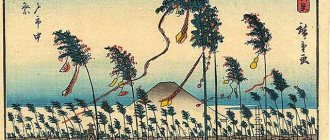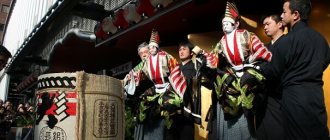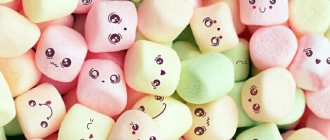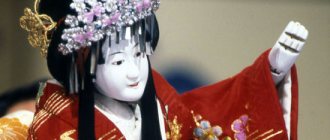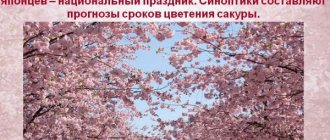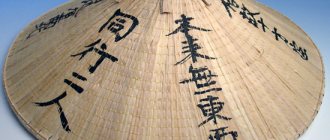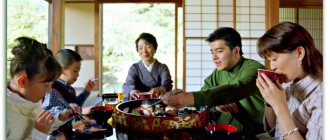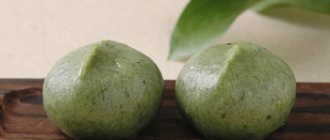Hinamatsuri is one of the most colorful, interesting and vibrant holidays in Japan. It is also called Girls' Day, which accurately reflects the essence of this day. The traditions of the celebration began several thousand years ago; the history of Hinamatsuri is rich in celebrations and important events.
Some holiday rituals may surprise you. For example, in the old days, a doll made in Hinamatsuri was used to wipe sore spots on the body, and in the evening, homemade baskets with dolls floated along the rivers. Why did the Japanese do this? And what rituals are observed today on Girls' Day?
Hinamatsuri - an ancient girls' festival in Japan
Memories of Heian Beauty
Celebrated on March 3 each year, Hinamatsuri is one of Japan's most beautiful unofficial holidays. The day when Japanese families with young daughters decorate their homes with decorative dolls (hina dolls) placed on platforms covered with red cloth.
The dolls are said to depict the emperor, empress, servants and musicians in traditional court garb from the Heian period. We use them to pray for the girls' well-being, health and, traditionally, a stable and successful marriage.
Precious dolls
The most spectacular and beloved custom of the holiday is the exhibition of hina-ningyo dolls. Families with girls set up a special podium covered with red material for elegant dolls. The first doll is usually given when a child is born. Over time, the family tries to assemble a collection.
This is not easy to do, since the dolls are made by hand and the cost of some copies can exceed a thousand dollars. If there are two or three daughters in a family, then they buy common dolls for everyone.
Ningyo dolls represent members of the imperial dynasty and courtiers. The Emperor and Empress or Prince and Princess wife are the most important and beautiful in the collection. They are installed at the very top of the stand, placing maids of honor, musicians and other servants on the lower steps.
Origin of Hinamatsuri
Like most traditional Japanese customs, Hinamatsuri is said to have begun as a custom to ward off evil demons and pray for a prosperous and healthy future. One of the earliest indirect references in The Tale of Genji states that the third day of the third month was a day of purification on which people were supposed to transfer evil spirits into dolls and release them into rivers and oceans.
In those days, people believed that dolls were capable of keeping evil spirits at bay. Families with girls made hina ningyo (雛人 h), or hina dolls, out of straw and sent them down the river on boats, supposedly taking all possible misfortunes with them. This practice is called hina nagashi (雛流し).
The custom evolved into displaying dolls on platforms covered with crimson colored cloth in Japan in the 17th century, when Princess Okiko, daughter of Emperor Go-Mizunoo, played with a dollhouse created especially for her.
When she came to the throne in 1687 as Empress Meiso, she popularized the holiday as Hinamatsuri. Since then, craftsmen throughout Japan have been designing various hina dolls for the holiday, a practice that continues to this day.
Girls' Day Festival "Hina Matsuri"
On March 3, Japan celebrates the Hina Matsuri holiday, also called the Doll Festival or Girls' Day. Most homes with girls display dolls and dedicate peach flowers, rice cake cubes, white sake and other items to them. The origin of Hina Matsuri is an ancient Chinese practice in which bodily sins and misfortunes are transferred to a doll and washed away when the doll is carried into the river. When this practice spread to Japan, it was associated with girls playing with dolls, and during the Edo period (17th-19th centuries) it became the Hina Matsuri holiday.
Why is Girls' Day celebrated on March 3?
In ancient China, there was a custom of making sacrifices and praying on days when the odd numbers 1, 3, 5, 7 and 9 overlapped with the same month as that number. These include Joshi (Momo no Sekku or Peach Blossom Festival) on March 3, Tango no Sekku (Boys' Day) on May 5, and Tanabata (Star Festival) July 7.
In Japan, the holiday on March 3 became an annual event during the Heian period (8th-12th centuries) and changed slightly during the Edo period (17th-19th centuries), becoming an official holiday of the shogunate. It was a very important holiday, a cheerful festival atmosphere reigned. Initially, the festival did not differentiate between men and women, but unlike Tango no Sekku (Boys' Day), where irises are hung, the Doll Festival has become a celebration of elegant girls.
During the Edo period (17th to 19th centuries), girls from aristocratic families were often sent to samurai families to marry, and Hina dolls were brought into samurai society as wedding paraphernalia.
Thus, playing with Hina dolls became popular among samurai and wealthy merchants. It seems that the habit of playing with Hina dolls gradually arose in connection with the peach blossom festival (momo no sekku), around the time of the eighth shogun Yoshimune Tokugawa (18th century). Peach blossoms usually occur from early March to mid-April. Since the peach blossom occurs during the spring season, the Joshi Festival is also called the "Peach Festival." In China, the peach tree is considered long-lived and represents youth and freshness.
Types of Hina dolls
There are two types of Hina dolls: "Kyo-bina", made in Kyoto, and "Kanto-bina", made in Kanto.
Kyo-bina
: narrow eye shape. The Emperor sits on the left side (and the doll's body is turned to the right), and the Empress sits on the right side.
Kanto-bina
: wide eye shape. The Emperor sits on the right (the body is turned to the left), and the Empress sits on the left side.
At one time in the imperial court, the "left side" was considered superior (for example, the minister on the left is taller than the one on the right), so in Kyoto the Hina doll "emperor" is on the left and the "empress" is on the right. Of course, in our time, you can arrange the emperor and empress according to your taste.
Types of decorations
Seven-level design:
First level: Emperor and Empress. These are the most expensive and beautiful dolls in the collection; they are dressed in beautiful festive clothes. Lanterns are placed on both sides of the dolls, and branches of a peach tree are placed between the dolls.
Second level: three court ladies holding sake utensils.
Third level: five musicians, the musicians hold either a flute or a drum in their hands, with the exception of one - the singer, who has a fan in his hands.
Fourth level: two minister figures are displayed.
Fifth level: they place servants.
6th and 7th levels: Wedding accessories such as dressing boxes, ox carts and caskets.
7 levels of decoration - this is the most luxurious way to decorate. A total of 15 people can be seated; this type of decoration is also called decoration for 15 people.
But there are also more modest types of jewelry:
Five-level decoration
: Up to 3rd tier is the same as 7 tier decoration, usually line up ministers and servants at 4th tier, and wedding supplies at 5th tier. This is also a decoration for 15 people.
Three-level design
: Up to the 3rd tier is the same as the 7-tier decoration, and the wedding supplies are placed between the musicians. It is also called a decoration for 10 people.
Decoration for two (Emperor and Empress):
They put decorations only from the emperor and empress, and this was normal until the Muromachi period (XIV-XVI centuries). Nowadays, there are many types of Hina dolls for home decoration, ranging from the number of levels that can be placed in the house to the price of these dolls.
When should you decorate Hina dolls?
One landmark is the beginning of spring (around February 3, when the Setsubun holiday
). In any case, you can decorate your house with dolls at least a week in advance. Do not rush to decorate on March 2, the day before, as this is called “decorating for the night” and is considered unfavorable. You can remove the dolls after March 4, but it is advisable to do this on a warm sunny day so that no moisture remains on the doll.
Dishes for the Hina Doll Festival
Clam soup - "Hamaguri no Suimono"
Rice cake – “Hishi-mochi”
Rice balls – “Hina-arare”
Chirashi sushi. Chirashi sushi uses: shrimp (to wish for longevity), lotus root (to wish for good vision), beans (to be healthy and work well). All these wishes are included in the colorful ingredients.
Hina Matsuri events throughout the country
Iwatsuki Doll Town (Saitama Prefecture)
In Iwatsuki, which has become a doll-making town, Hina doll events are held every year for two weeks from late February to early March. Hina dolls are displayed in the shopping area every year. Also common are large decorations for the steps of the Atago Shrine, which are only available on Saturdays and Sundays.
Awa Katsuura Big Hina Festival (Tokushima Prefecture)
A magnificent Hina Matsuri event featuring over 30,000 Hina dolls with 100-level designs.
Yanagawa Puppet Festival held on the Sagemon River (Fukuoka Prefecture)
The traditional Yanagawa Doll Festival features decorations for Hina dolls, handmade from colorful fabric. The events are held every year from mid-February to early April, with the "Ohina-sama Water Parade" in mid-March.
Not only in Japan, girls' day is celebrated in March; in Russia, on March 8, we celebrate another holiday - International Women's Day. Congratulations to all women on the holiday of spring, charm, beauty and femininity! Let every day be like this: filled with smiles, admiration, love, care and joy. Be happy, feeling like women, princesses, queens. Happy March 8, dear ladies!
Health and beauty to you!
How is Hinamatsuri celebrated in Japan?
Nowadays, most families with daughters decorate their homes, usually with five-seven tiered platforms of Hina dolls. Decorating dolls begins in mid-February and is left until the end of March 3. Traditionally, grandparents or parents of a newborn girl buy a set of Hina doll jewelry for the child's first Hinamatsuri.
Families remove decorations immediately after Hinamatsuri as superstitions claim that keeping the dolls after March 4 will result in late marriage for daughters. In some areas of Japan, people still release paper dolls into the water after the holiday, praying for health and good luck.
When the peaches bloom
In ancient times, on the “third day of the third moon,” peasants celebrated the onset of a short rest between large agricultural works. This period coincided with the beginning of the peach blossoms, and everyone admired the beautiful trees. This is how one of the names of this holiday arose: Momo no sekku - “Peach Blossom Festival”.
In East Asian cultures, the peach symbolizes protection from evil spirits, so its flowers were used both as home decoration and as a talisman. The Japanese associate peach with the beginning of spring, freshness, as well as feminine fragility and beauty.
The second name of the holiday is Hina Matsuri - “Hina Doll Festival.” It arose from an ancient ritual that was performed by priests on this day. Doll figures of a “boy” and a “girl” were made from paper, all troubles and misfortunes were “transferred” to them using special rituals and then thrown into the water, burned or buried.
This is how the Japanese got rid of evil and filth in order to meet spring clean and renewed. Later, dolls began to be made from clay. And no longer destroy it, but keep it in the house as a symbol of happiness and health. And during the reign of the eighth shogun of the Tokugawa dynasty, Yoshimune, the father of many daughters, the holiday became widespread and took shape in the form already known to us.
Delicious holiday
However, in addition to decorating the floats with gorgeous dolls, the Japanese also celebrate this day by preparing special foods and drinks.
First of all, a common drink for everyone (including children) is shirozake (白酒). It consists of sweet sake that contains enough alcohol (nine percent) to make parents wince. However, traditional dishes are more child-friendly and colorful.
Hina arare
Arare (reられ) is a rice cracker named after hail or snow pellets. Typically, hina arare are colorful and flavored with soy sauce or sugar, depending on the region.
Hishi mochi
Another sweet delicacy would be Hishi mochi (菱餅), a multi-layered rice cake, with flowers of red (pink), white and green. In some areas of Japan, the color red is replaced by yellow, and there may be five or seven layers of mochi instead of three. The sweet diamond was believed to symbolize fertility in the Edo era.
Chirashizushi
If you prefer something savory, Chirashizushi (ちらし寿司) is a rice dish seasoned with vinegar, sugar and a pinch of salt, topped with assorted sashimi and a variety of other ingredients that form different layers and come in a variety of beautiful and vibrant colors.
Ushiojiru
Finally, Ushiojiru (潮汁) is a clear broth-based soup containing "hard shellfish" as the main ingredient. The shells symbolize the unity and peacefulness of the couple, since only two perfectly symmetrical double shells can fit tightly together.
The only real prep work that needs to be done is soaking the clams in salt water for a few hours to help them get rid of the sand and dirt (sand clams are NOT tasty). One of the keys to a delicious broth is skimming off the scum that collects on the top of the water (trust me, scum is NOT tasty either).
They say that, like snowflakes, no two shells are alike. Ushiojiru is also a dish where you enjoy the soup more than the meat itself.
These days, many people buy beautifully decorated and very feminine cakes and other sweets to celebrate this day.
If you have a daughter, celebrate this day like a local and decorate your own hina dolls at home. Don't forget to put your dolls away in closets on March 4th so that your dear little ones can grow up happy and healthy!
Happy Hinamatsuri!
Celebration in modern times
The Japanese know many other names for Hinamatsuri. It is called the Festival of the First Day of the Snake (which corresponds to the local calendar) or the Festival of the Blossoming Peach. But the main symbol of the day remains the paper doll. These toys are called hina ningyo, the appearance of which was finally formed in the Edo era.
Nowadays, Hinamatsuri is no less bright and colorful than in ancient times. Families with daughters begin preparing for the holiday in advance. Special fairs are opened in cities where you can buy dolls or blanks for making them.
Mothers of girls share ideas, exchange impressions of last year's holiday, purchase toy furniture, special stands for dolls, outfits and decorations. At fairs you can choose holiday sweets that are customary to treat guests to. All of them are connected with the idea of a holiday.
On the holiday, girls dress in elegant kimonos with floral patterns, go on a visit, and have fun get-togethers with friends. The hero of the occasion treats their guests with special delicacies - lush hisi mochi and hina arare sweets made from rice.
Older girls and adult women can afford low-alcohol sake, but it is important to follow the rules of good manners. Hinamatsuri is a great opportunity to demonstrate the excellent upbringing of your daughter to guests, and for a girl it is a sure way to make a good impression.
Hamaguri Ushio-jiru (clear clam soup)
Serves 4
8 small (or 4 large) clams 4-inch square kombu 3 1/4 cups cold water 3/4 teaspoons mitsuba salt parsley or cilantro for garnish lemon zest, finely grated for garnish
1. To prepare the clams: Place the clams in a large bowl and cover with heavily salted water. Let them sit in a cool, dark place for 2 to 5 hours. this helps them remove any sand or dirt that may have gotten into them. Once the clams are soaked, gently rinse the shells under cold running water.
2. To make the soup: Place clams, kombu and cold water in a medium saucepan. Place the pan over medium-high heat. Before the water boils, remove the algae. Boil the water until all the clams have opened, then season the broth with salt and skim off any scum from the surface of the water. Remove the clams, then pour the broth through a fine-mesh sieve (or 2 layers of cheesecloth) into another saucepan.
3. Serve: Place 2 clams, a sprig of mitsuba, parsley, cilantro and a pinch of lemon zest on each plate. Pour in the hot broth and serve.
Views: 1,814
Share link:
- Tweet
- Share posts on Tumblr
- Telegram
- More
- by email
- Seal
Liked this:
Like
Hinamatsuri near Tokyo
Every year during February and March, Keio Plaza Hotel celebrates Girls' Day by displaying thousands of hand-crafted silk tsurushi-bina dolls. They also offer a special menu in honor of Hinamatsuri.
The Hyakudan Hinamatsuri exhibition at the Gajoen Hotel in Meguro features antique decorative dolls from various prefectures in Japan.
The city of Katsuura in Chiba Prefecture, about 2 hours from Tokyo, hosts a grand event every year to celebrate Girls' Day. There you can enjoy a huge display of dolls on the steps of the Tomisaki Shrine, as well as other decorations (about 30,000 hina dolls!).
To learn more about seasonal Japanese festivals and traditions, be sure to follow our blog.
